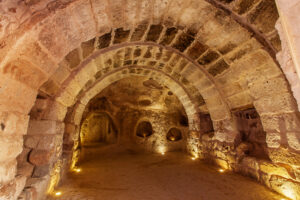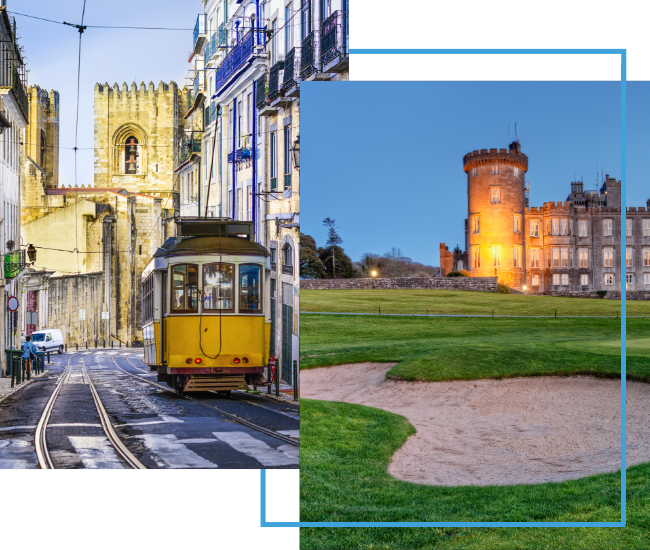Every city has hidden depths. Beneath the streets lie extensive networks for essential utilities. Many cities also construct subterranean networks for transport, storage, shopping, refuge, burial and even housing. These underground worlds may originally be natural or entirely manmade. They may be open to all or off-limits. And most people remain oblivious of their existence.
That’s true of Vienna, where the majority of visitors don’t notice the petal-like metal cover embedded into cobbles in Girardi Park, a sliver of open space amid a busy intersection. If you’ve seen the classic 1949 film The Third Man, in which Orson Welles plays a man running for his life, you know the metal cover provides a portal to an underground labyrinth. On The Third Man Tour — at 3 p.m. Thursdays through Sundays from May to October — your guide will peel open the metal cover to reveal spiral steps. Down you go, into the sewer.
The movie culminates with a memorable chase sequence filmed within this small section of Vienna’s 1,550-mile-long sewer system. Down here, within sturdy arched tunnels, the city feels distant. Does it stink? Not as badly as you’d imagine, and if you visit on the weekend, when many locals do their washing, soap suds mask the worst of the stench.
In Paris, just a couple of blocks from the Eiffel Tower, explore an entire museum dedicated to the sewer system. Musée des égouts de Paris encompasses a third of a mile of tunnels. There’s a dry section, with permanent displays about the history and operations of the system, and a wet section, in which visitors get to walk along walkways above the flowing sewers. (The wet section closes when the water level is too high.)

© BUKKI88 | DREAMSTIME
To the south, under the Parisian district of Montparnasse, lies one of the world’s creepiest subterranean landmarks, the Catacombs of Paris. The stone that built the city was excavated from this area, leaving behind a huge warren of manmade caves five stories beneath the surface. In the 18th century these caves became ossuaries for the dead, and in time the remains of more than 6 million people were interred here.
The catacombs have since become an unlikely tourist attraction and are so popular, you’re advised to book a time slot for your visit at least a week in advance. Visitors descend 131 steps and enter the tunnels under an engraved sign proclaiming, “Arrête! C’est ici l’empire de la mort.” (“Stop! This is the empire of the dead.”) Sure enough, the dead lie everywhere: Bones and skulls are stacked into the walls of the corridors and chambers of the 1-mile route. This eerie netherworld is cold and humid and certainly not for the faint-hearted. But few places immerse you in history quite like the catacombs. They have shaped Paris not just below ground but also on the surface. The buildings immediately above are predominantly low- rise because the hollow ground won’t support tall buildings.
Rome is another European city with an extensive historical underworld. The city’s bedrock is riven with tunnels and crypts, many dating back more than 2,000 years. The Domitilla Catacombs cover an area of more than 10 miles, hold the remains of 150,000 people and even feature an ancient underground Christian basilica. The Catacombs of Callixtus include the Crypt of the Popes; so many popes have been interred here, the catacombs are nicknamed “Little Vatican.”
Subterranean worlds are often shrouded in mystery. In Rome it is often claimed the catacombs were created by Christians forbidden from worshipping or burying their dead within the city walls, and so they went underground. Many historians dispute this and insist the main reason for going underground was the high price of land on the surface.
Even recent history is subject to debate. Beneath Portland, Oregon, a complex of linked passages and basements has collectively become known as the Shanghai Tunnels. Visitors can see a small section on group tours. According to legend, these tunnels were used for smuggling goods and to kidnap — or “shanghai” — able men for service on ships in the nearby port. The truth is probably less dramatic: They merely provided a means of delivering goods without being obstructed by traffic and people in the streets.
Similarly, in Moose Jaw, Canada, there have long been stories of tunnels which provided refuge for Chinese immigrants and were subsequently used by Al Capone to store liquor during Prohibition and then as a 1950s Cold War bunker. The Tunnels of Moose Jaw is a popular visitor attraction offering interactive, theatrical tours bringing this underworld history to life. The reality is contested, and most historians claim the existence of an extensive tunnel network under Moose Jaw is an urban myth. Still, the tours are fun and provide an immersive experience of three eras of North American history.

PHOTO:
© IGOR STRAMYK
| DREAMSTIME
The existence of underground cities in Türkiye is beyond doubt, though mysteries remain as to exactly when they were built and who built them. Until recently, the largest was thought to be Derinkuyu in Cappadocia, which may have been excavated by the Phrygians more than 3,000 years ago. Carved into volcanic rock, with connected tunnels and chambers extending to 18 levels, it was inhabited for centuries, supporting up to 20,000 residents. Intriguingly, recent research suggests the existence of up to 200 underground cities in the region, all interconnected. It’s thought their main purpose was to protect the population from foreign invaders.
In modern cities there are other reasons to take shelter. The weather, for instance. In Toronto the severe winters are mitigated by PATH, a network of tunnels extending 19 miles, connecting 70 buildings, and housing more than 1,200 shops. It is acknowledged as the world’s largest underground shopping complex.
Similar underground malls provide refuge from heat or cold, or traffic and pollution in the United States (including Houston, Oklahoma City and Philadelphia); South Korea (central Seoul); Japan (especially Fukuoka and Tokyo); and China (numerous cities). In Kansas City a 1,100-acre former limestone mine has been transformed into SubTropolis, a huge underground system of tunnels and storerooms used for logistics and storage.
Not all of these networks have thrived. In Texas the Dallas Pedestrian Network, conceived in 1969, was once a comprehensive system of tunnels and shops under downtown. Section closures and private owners blocking access reduced its viability, and now most people at street level — visitors and locals alike — are unaware of its existence.

© MEHMET CETIN | DREAMSTIME
How easy it is for a society to forget its heritage. In 2020 in the Turkish town of Midyat on the border with Syria — hundreds of miles from the well-known sites in Cappadocia — workers on a construction project broke through into an ancient tunnel. It soon became apparent they had discovered a lost underground city, Matiate. Only about 3 percent of the city has been excavated so far, but early estimates suggest it was inhabited for 2,000 years and was home to 70,000 people, making it the largest underground city ever discovered, complete with underground churches and a synagogue. When it comes to discovering our subterranean history, we’ve barely scratched the surface.
Read This Next

Introducing
FX Excursions
FX Excursions offers the chance for once-in-a-lifetime experiences in destinations around the world.
#globility
Insta FeedDaily
May 14, 20256 Unforgettable Dining Experiences Around the World
Hungry for adventure? These destinations offer unique dining experiences worth the trip.
Sponsored Content
Explore Europe with the Best River Cruise Line this November
Experience Europe from a fresh perspective with AmaWaterways, just awarded Best River Cruise Line by Global Traveler for the third consecutive year. Step aboard, unpack once and embark on a cruise through iconic capital cities and awe-inspiring landscapes. AmaWaterways' ships, which accommodate an average of just 156 guests, offer a spacious yet intimate setting. Throughout your journey, you'll enjoy exquisite farm-to-table dining; unparalleled service; and a variety of included excursions, from city tours for gentle walkers to thrilling bike rides along the rivers.
eFlyer Reviews
May 14, 2025Hotel Van Zandt Review
One step onto Austin’s Rainey Street and you’ll feel like you’ve joined the cool kids at the best playground in the city. Just behind the cottage bars, pint-sized skyscrapers soar. One of them, Hotel Van Zandt, the Rainey district's pièce de resistance, beckons with a song-like spirit —apropos because the independently owned property, rife with music motifs, was named after beloved singer-songwriter Townes Van Zandt. Sixteen stories high, the hotel embodies Austin’s lust for music, manifesting with a vinyl corner; trumpet chandeliers; myriad musical references; replica vintage posters in frames; and its own live music venue, which doubles as its acclaimed restaurant, Geraldine’s. Don’t miss the mesmerizing installation of colorful origami-like birds composed from vinyl records that flitter from an old phonograph.
eFlyer News
May 14, 2025National Geographic-Lindblad Expeditions Enters European River Cruise Market with 2026 Itineraries
National Geographic-Lindblad Expeditions recently announced its inaugural European river cruises, with bookings open for its 2026 sailings on May 20. Travelers can choose from two options, each focusing on different destinations and activities.
Sponsored Content
Royal Air Maroc Introduces Groundbreaking Safety Video: A Captivating Invitation to Discover Moroccan Heritage
Royal Air Maroc continues to elevate the passenger experience with the launch of its new in-flight safety video — a cinematic journey that seamlessly blends essential safety instructions with a celebration of Moroccan cultural heritage.
eFlyer News
May 14, 2025Alaska Airlines, Hawaiian Airlines Launch Daily Service Between Seattle and Tokyo
Alaska Airlines launches a new global connection between the Pacific Northwest and Japan with a Hawaiian Airlines-operated flight. The new service between Seattle (SEA) and Tokyo (NRT) begins Sept. 12.
Viking Launches Exclusive May Sales
eFlyer Deals
May 14, 2025World Cruises: A Growing Trend?
eFlyer Lead
May 14, 2025Daily
May 13, 2025Hot Destination Addresses for Sound Bath Experiences
If you haven’t heard about the wellness trend of sound bathing, you may not have been listening.
Sponsored Content
Find Your Perfect Escape with Paradisus by Meliá — More Than Just All-Inclusive
Luxury travel today is about more than just beautiful accommodations — it’s about experiencing the destination. Paradisus by Meliá takes traditional all-inclusive resorts to the next level by offering indulgence with immersion, experiences and authenticity. Each resort is shaped by its location, local flavors and curated Destination Inclusive® experiences that bring you closer to the heart of the destination.
May 2025
May 13, 2025Explore Fakarava’s Breathtaking Beauty and Biodiversity
You’ll hardly discover the 118 islands of French Polynesia in a single stopover. And as any seasoned sailor in these parts will tell you, even a lifetime of exploring this incredible part of the world may not provide enough time.
ShareThis